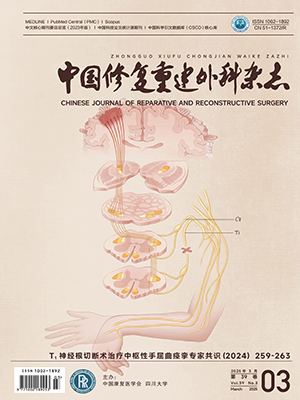Objective To investigate the efficacy of sequential treatment with adductor canal nerve block (ACNB) and cyclooxygenase 2 (COX-2) selective inhibitor (parecoxib and celecoxib) after primary total knee arthroplasty (TKA).
Methods Between January 2015 and December 2015, 90 osteoarthritis patients who met the inclusion criteria were treated, and randomly divided into 3 groups:ACNB+COX-2 group (group A, n=30), COX-2 group (group B, n=30), and control group (group C, n=30). There was no significant difference in gender, age, body mass index, side, and osteoarthritis duration between groups (P > 0.05), and the data were comparable. ACNB was used in group A at the end of TKA. Intravenous injection of parecoxib (40 mg per 12 hours) was administrated at the first three postoperative days, and followed by oral celecoxib (200 mg per 12 hours) until 6 weeks after operation in groups A and B; while placebo was given at the same time point in group C. Oral tramadol or intravenous morphine, as remedial measures, were introduced when patients had a visual analogue scale (VAS) score more than 4. The following indicators were compared between groups:the operative time, drainage volume at 24 hours after operation, length of hospital stay, and incidence of side effect; VAS pain scores, morphine consumption, range of motion (ROM) of the knee joint, and inflammatory cytokines levels at pre-operation and at 1 day, 2 days, 3 days, 1 week, 2 weeks, 4 weeks, and 6 weeks after operation; morphine consumption within first 24 hours and at 24 hours to 6 weeks after operation; the American Hospital for Special Surgery (HSS) score at 1, 2, 4, and 6 weeks after operation; and the serum coagulation parameters at pre-operation, and at 1, 3, and 14 days after operation.
Results The length of hospital stay was significantly shorter and the incidence of postoperative nausea and vomiting was significantly lower in groups A and B than group C (P < 0.05). The VAS scores at rest (VASR) of groups A and B were significantly lower than that of group C at 1, 2, and 3 days after operation (P < 0.05); difference in the VAS scores at walking (VASW) was significant between groups at 1 day after operation (P < 0.05), and group A had the lowest VASW; and the VASW of groups A and B were significantly lower than that of group C at 2 and 3 days and at 1, 2, 4, and 6 weeks after operation (P < 0.05). The difference in morphine consumption was significant between groups within the first 24 hours after operation (P < 0.05), and group A exhibited the lowest consumption; and the morphine consumption in groups A and B was significantly lower than that in group C at 24 hours to 6 weeks after operation (P < 0.05). Significant difference was found in HSS scores between groups at 1, 2, 4, and 6 weeks after operation, and group A showed the highest score (P < 0.05). At 1 and 2 days after operation, group A showed the highest ROM (P < 0.05), and ROM of groups A and B was significantly higher that of group C at 3 days, 1 week, 2 weeks, 4 weeks, and 6 weeks after operation (P < 0.05). Groups A and B were significantly lower than group C in the serum erythrocyte sedimentation rate at 2 days, 3 days, 1 week, 2 weeks, 4 weeks, and 6 weeks, in C-reactive protein levels at 1, 2, and 3 days, in interleukin 6 (IL-6) and TNF-α levels at 1 day to 6 weeks, and in IL-8 level at 2 and 3 days (P < 0.05). The drainage volume within the first 24 hours and the serum coagulation parameters within the 2 weeks after operation showed no significant difference between groups (P > 0.05).
Conclusion Sequential treatment with ACNB and COX-2 selective inhibitor is a safe and effective approach for postoperative pain management after primary TKA, and it can alleviate postoperative pain, promote the joint function recovery, and reduce the risk of adverse reactions.
Citation:
YANGTimin, SIHaibo, WUYuangang, ZENGYi, PEIFuxing, WENGXisheng, SHENBin. EFFICACY OF SEQUENTIAL TREATMENT WITH ADDUCTOR CANAL NERVE BLOCK AND CYCLOOXYGENASE 2 SELECTIVE INHIBITOR AFTER TOTAL KNEE ARTHROPLASTY. Chinese Journal of Reparative and Reconstructive Surgery, 2016, 30(9): 1065-1071. doi: 10.7507/1002-1892.20160217
Copy
Copyright © the editorial department of Chinese Journal of Reparative and Reconstructive Surgery of West China Medical Publisher. All rights reserved





 Baidu Scholar
Baidu Scholar